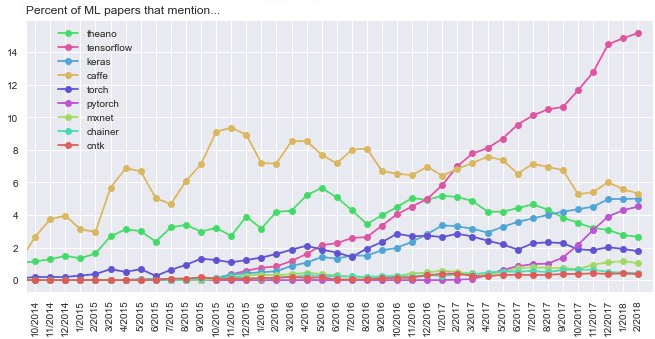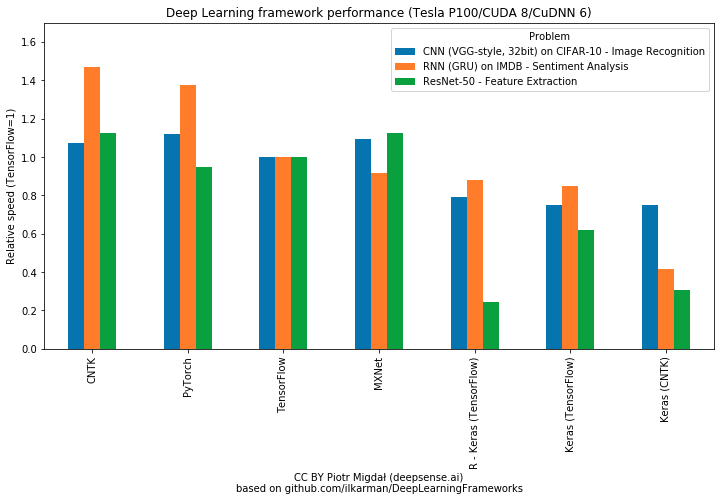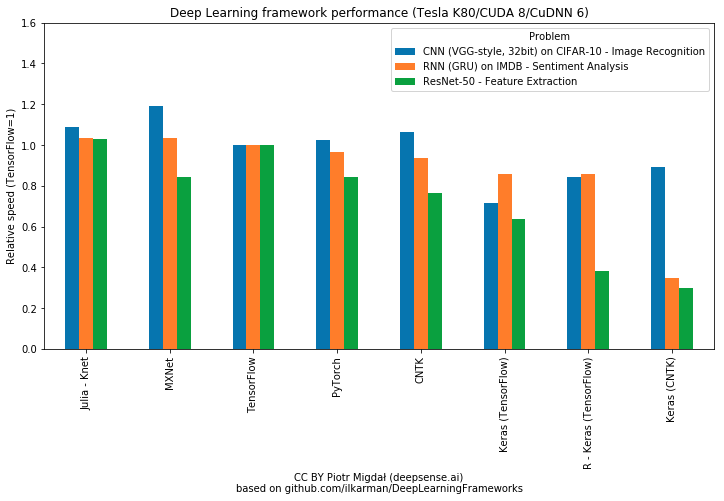Keras vs. PyTorch
We strongly recommend that you pick either Keras or PyTorch. These are powerful tools that are enjoyable to learn and experiment with. We know them both from the teacher’s and the student’s perspective. Piotr has delivered corporate workshops on both, while Rafał is currently learning them.(See the discussion on Hacker News and Reddit).
Introduction
Keras and PyTorch are open-source frameworks for deep learning gaining much popularity among data scientists.
- Keras is a high-level API capable of running on top of TensorFlow, CNTK, Theano, or MXNet (or as tf.contrib within TensorFlow). Since its initial release in March 2015, it has gained favor for its ease of use and syntactic simplicity, facilitating fast development. It’s supported by Google.
- PyTorch, released in October 2016, is a lower-level API focused on direct work with array expressions. It has gained immense interest in the last year, becoming a preferred solution for academic research, and applications of deep learning requiring optimizing custom expressions. It’s supported by Facebook.
Before we discuss the nitty-gritty details of both frameworks (well described in this Reddit thread), we want to preemptively disappoint you – there’s no straight answer to the ‘which one is better?’. The choice ultimately comes down to your technical background, needs, and expectations. This article aims to give you a better idea of where each of the two frameworks you should be pick as the first.
TL;DR:
Keras may be easier to get into and experiment with standard layers, in a plug & play spirit.
PyTorch offers a lower-level approach and more flexibility for the more mathematically-inclined users.
Ok, but why not any other framework?
TensorFlow is a popular deep learning framework. Raw TensorFlow, however, abstracts computational graph-building in a way that may seem both verbose and not-explicit. Once you know the basics of deep learning, that is not a problem. But for anyone new to it, sticking with Keras as its officially-supported interface should be easier and more productive.
[Edit: Recently, TensorFlow introduced Eager Execution, enabling the execution of any Python code and making the model training more intuitive for beginners (especially when used with tf.keras API).]
While you may find some Theano tutorials, it is no longer in active development. Caffe lacks flexibility, while Torch uses Lua (though its rewrite is awesome :)). MXNet, Chainer, and CNTK are currently not widely popular.
Keras vs. PyTorch: Ease of use and flexibility
Keras and PyTorch differ in terms of the level of abstraction they operate on.
Keras is a higher-level framework wrapping commonly used deep learning layers and operations into neat, lego-sized building blocks, abstracting the deep learning complexities away from the precious eyes of a data scientist.
PyTorch offers a comparatively lower-level environment for experimentation, giving the user more freedom to write custom layers and look under the hood of numerical optimization tasks. Development of more complex architectures is more straightforward when you can use the full power of Python and access the guts of all functions used. This, naturally, comes at the price of verbosity.
Consider this head-to-head comparison of how a simple convolutional network is defined in Keras and PyTorch:
Keras
model=Sequential()
model.add(Conv2D(32,(3,3),activation='relu',input_shape=(32,32,3)))
model.add(MaxPool2D())
model.add(Conv2D(16,(3,3),activation='relu'))
model.add(MaxPool2D())
model.add(Flatten())
model.add(Dense(10,activation='softmax'))
PyTorch
classNet(nn.Module):
def __init__(self):
super(Net,self).__init__() self.conv1=nn.Conv2d(3,32,3)
self.conv2=nn.Conv2d(32,16,3)
self.fc1=nn.Linear(16*6*6,10)
self.pool=nn.MaxPool2d(2,2) def forward(self,x):
x=self.pool(F.relu(self.conv1(x)))
x=self.pool(F.relu(self.conv2(x)))
x=x.view(-1,16*6*6)
x=F.log_softmax(self.fc1(x),dim=-1) returnx model=Net()
The code snippets above give a little taste of the differences between the two frameworks. As for the model training itself – it requires around 20 lines of code in PyTorch, compared to a single line in Keras. Enabling GPU acceleration is handled implicitly in Keras, while PyTorch requires us to specify when to transfer data between the CPU and GPU.
If you’re a beginner, the high-levelness of Keras may seem like a clear advantage. Keras is indeed more readable and concise, allowing you to build your first end-to-end deep learning models faster, while skipping the implementational details. Glossing over these details, however, limits the opportunities for exploration of the inner workings of each computational block in your deep learning pipeline. Working with PyTorch may offer you more food for thought regarding the core deep learning concepts, like backpropagation, and the rest of the training process.
That said, Keras, being much simpler than PyTorch, is by no means a toy – it’s a serious deep learning tool used by beginners, and seasoned data scientists alike.
For instance, in the Dstl Satellite Imagery Feature Detection Kaggle competition, the 3 best teams used Keras in their solutions, while our deepsense.ai team (4th place) used a combination of PyTorch and (to a lesser extend) Keras.
Whether your applications of deep learning will require flexibility beyond what pure Keras has to offer is worth considering. Depending on your needs, Keras might just be that sweet spot following the rule of least power.
SUMMARY
- Keras – more concise, simpler API
- PyTorch – more flexible, encouraging deeper understanding of deep learning concepts
Keras vs. PyTorch: Popularity and access to learning resources
A framework’s popularity is not only a proxy of its usability. It is also important for community support – tutorials, repositories with working code, and discussions groups. As of June 2018, Keras and PyTorch are both enjoying growing popularity, both on GitHub and arXiv papers (note that most papers mentioning Keras mention also its TensorFlow backend). According to a KDnuggets survey, Keras and PyTorch are the fastest growing data science tools.
Unique mentions of deep learning frameworks in arxiv papers (full text) over time, based on 43K ML papers over last 6 years. So far TF mentioned in 14.3% of all papers, PyTorch 4.7%, Keras 4.0%, Caffe 3.8%, Theano 2.3%, Torch 1.5%, mxnet/chainer/cntk <1%. (cc @fchollet) pic.twitter.com/YOYAvc33iN
— Andrej Karpathy (@karpathy) 10 marca 2018
While both frameworks have satisfactory documentation, PyTorch enjoys stronger community support – their discussion board is a great place to visit to if you get stuck (you will get stuck) and the documentation or StackOverflow don’t provide you with the answers you need.
Anecdotally, we found well-annotated beginner level deep learning courses on a given network architecture easier to come across for Keras than for PyTorch, making the former somewhat more accessible for beginners. The readability of code and the unparalleled ease of experimentation Keras offers may make it the more widely covered by deep learning enthusiasts, tutors and hardcore Kaggle winners.
For examples of great Keras resources and deep learning courses, see “Starting deep learning hands-on: image classification on CIFAR-10“ by Piotr Migdał and “Deep Learning with Python” – a book written by François Chollet, the creator of Keras himself. For PyTorch resources, we recommend the official tutorials, which offer a slightly more challenging, comprehensive approach to learning the inner-workings of neural networks. For a concise overview of PyTorch API, see this article.
SUMMARY
- Keras – Great access to tutorials and reusable code
- PyTorch – Excellent community support and active development
Keras vs. PyTorch: Debugging and introspection
Keras, which wraps a lot of computational chunks in abstractions, makes it harder to pin down the exact line that causes you trouble.
PyTorch, being the more verbose framework, allows us to follow the execution of our script, line by line. It’s like debugging NumPy – we have easy access to all objects in our code and are able to use print statements (or any standard Pythonic debugging) to see where our recipe failed.
A Keras user creating a standard network has an order of magnitude fewer opportunities to go wrong than does a PyTorch user. But once something goes wrong, it hurts a lot and often it’s difficult to locate the actual line of code that breaks. PyTorch offers a more direct, unconvoluted debugging experience regardless of model complexity. Moreover, when in doubt, you can readily lookup PyTorch repo to see its readable code.
SUMMARY
- PyTorch – way better debugging capabilities
- Keras – (potentially) less frequent need to debug simple networks
Keras vs. PyTorch: Exporting models and cross-platform portability
What are the options for exporting and deploying your trained models in production?
PyTorch saves models in Pickles, which are Python-based and not portable, whereas Keras takes advantages of a safer approach with JSON + H5 files (though saving with custom layers in Keras is generally more difficult). There is also Keras in R, in case you need to collaborate with a data analyst team using R.
Running on Tensorflow, Keras enjoys a wider selection of solid options for deployment to mobile platforms through TensorFlow for Mobile and TensorFlow Lite. Your cool web apps can be deployed with TensorFlow.js or keras.js. As an example, see this deep learning-powered browser plugin detecting trypophobia triggers, developed by Piotr and his students.
Exporting PyTorch models is more taxing due to its Python code, and currently the widely recommended approach is to start by translating your PyTorch model to Caffe2 using ONNX.
SUMMARY
- Keras – more deployment options (directly and through the TensorFlow backend), easier model export.
Keras vs. PyTorch: Performance
Donald Knuth famously said:
Premature optimization is the root of all evil (or at least most of it) in programming.
In most instances, differences in speed benchmarks should not be the main criterion for choosing a framework, especially when it is being learned. GPU time is much cheaper than a data scientist’s time. Moreover, while learning, performance bottlenecks will be caused by failed experiments, unoptimized networks, and data loading; not by the raw framework speed. Yet, for completeness, we feel compelled to touch on this subject. We recommend these two comparisons:
- TensorFlow, Keras and PyTorch comparison by Wojtek Rosiński
- Comparing Deep Learning Frameworks: A Rosetta Stone Approach by Microsoft (make sure to check notebooks to get the taste of different frameworks). For a detailed explanation of the multi-GPU framework comparisons, see this article.
PyTorch is as fast as TensorFlow, and potentially faster for Recurrent Neural Networks. Keras is consistently slower. As the author of the first comparison points out, gains in computational efficiency of higher-performing frameworks (ie. PyTorch & TensorFlow) will in most cases be outweighed by the fast development environment, and the ease of experimentation Keras offers.


SUMMARY:
- As far as training speed is concerned, PyTorch outperforms Keras
Keras vs. PyTorch: Conclusion
Keras and PyTorch are both excellent choices for your first deep learning framework to learn.
If you’re a mathematician, researcher, or otherwise inclined to understand what your model is really doing, consider choosing PyTorch. It really shines, where more advanced customization (and debugging thereof) is required (e.g. object detection with YOLOv3 or LSTMs with attention) or when we need to optimize array expressions other than neural networks (e.g. matrix decompositions or word2vec algorithms).
Keras is without a doubt the easier option if you want a plug & play framework: to quickly build, train, and evaluate a model, without spending much time on mathematical implementation details.
EDIT: For side-by-side code comparison on a real-life example, see our new article: Keras vs. PyTorch: Alien vs. Predator recognition with transfer learning.
Knowledge of the core concepts of deep learning is transferable. Once you master the basics in one environment, you can apply them elsewhere and hit the ground running as you transition to new deep learning libraries.
We encourage you to try out simple deep learning recipes in both Keras and PyTorch. What are your favourite and least favourite aspects of each? Which framework experience appeals to you more? Let us know in the comment section below!
Would you and your team like to learn more about deep learning in Keras, TensorFlow and PyTorch? See our tailored training offers.
Keras vs. PyTorch的更多相关文章
- Keras vs. PyTorch in Transfer Learning
We perform image classification, one of the computer vision tasks deep learning shines at. As traini ...
- 深度学习框架Keras与Pytorch对比
对于许多科学家.工程师和开发人员来说,TensorFlow是他们的第一个深度学习框架.TensorFlow 1.0于2017年2月发布,可以说,它对用户不太友好. 在过去的几年里,两个主要的深度学习库 ...
- Ubuntu在Anaconda中安装TensorFlow GPU,Keras,Pytorch
安装TensorFlow GPU pip install --ignore-installed --upgrade tensorflow-gpu 安装测试: $ source activate tf ...
- Hinton's paper Dynamic Routing Between Capsules 的 Tensorflow , Keras ,Pytorch实现
Tensorflow 实现 A Tensorflow implementation of CapsNet(Capsules Net) in Hinton's paper Dynamic Routing ...
- PyToune:一款类Keras的PyTorch框架
PyToune is a Keras-like framework for PyTorch and handles much of the boilerplating code needed to t ...
- [转] 理解CheckPoint及其在Tensorflow & Keras & Pytorch中的使用
作者用游戏的暂停与继续聊明白了checkpoint的作用,在三种主流框架中演示实际使用场景,手动点赞. 转自:https://blog.floydhub.com/checkpointing-tutor ...
- 常用深度学习框——Caffe/ TensorFlow / Keras/ PyTorch/MXNet
常用深度学习框--Caffe/ TensorFlow / Keras/ PyTorch/MXNet 一.概述 近几年来,深度学习的研究和应用的热潮持续高涨,各种开源深度学习框架层出不穷,包括Tenso ...
- 神经网络架构PYTORCH-初相识(3W)
who? Python是基于Torch的一种使用Python作为开发语言的开源机器学习库.主要是应用领域是在自然语言的处理和图像的识别上.它主要的开发者是Facebook人工智能研究院(FAIR)团队 ...
- (转)Awesome PyTorch List
Awesome-Pytorch-list 2018-08-10 09:25:16 This blog is copied from: https://github.com/Epsilon-Lee/Aw ...
随机推荐
- nc,远程传输文件
linux互传文件nc命令 使用nc命令可以很快的在两台主机传递文件,且不需要在同一网段,只要设置好端口即可. 一.安装(CentOS下) yum install -y nc (需要root权限 ...
- 转MVC3介绍
第一节:Asp.Net MVC3项目介绍 让我们先看一下,一个普通的Asp.Net MVC3项目的样例,如下图所示 跟WebFrom还是有区别的,如果你已经了解Asp.Net MVC2的话,那就感觉异 ...
- (转)支持Multi Range Read索引优化
支持Multi Range Read索引优化 原文:http://book.51cto.com/art/201701/529465.htm http://book.51cto.com/art/2016 ...
- 再学Java 之 Integer 包装类缓存
前言:本博文将涉及的Java的自动装箱和自动拆箱,可以参考 这篇文章 和 官方教程 ,这里不再赘述. 首先,先看一个小程序: public class Main { public static voi ...
- Android_设置全屏的方法
在开发的过程中,我们有时候需要让我们应用程序全屏或者是让某个页面全屏,在今天的android小技巧中我们来讲讲如何设置我们的应用程序 全屏: 通常我们有三种方式: 1.在onCreate方法中添加代码 ...
- SpringMVC和dubbo简单的整合(附Demo)
顺便记录下apache产品提供下载的网址:http://mirrors.shuosc.org/apache/ 第一步: 下载zookeeper,网址:http://mirrors.shuosc.org ...
- nginx 学习笔记(2) nginx新手入门
这篇手册简单介绍了nginx,并提供了一些可以操作的简单的工作.前提是nginx已经被安装到你的服务器上.如果没有安装,请阅读上篇:nginx 学习笔记(1) nginx安装.这篇手册主要内容:1. ...
- Linq之Distinct详解
前天在做批量数据导入新增时,要对数据进行有效性判断,其中还要去除重复,如果没出现linq的话可能会新声明一个临时对象集合,然后遍历原始数据判断把符合条件的数据添加到临时集合中,这在有了linq之后显得 ...
- CLR via C# 读书笔记-26.线程基础
前言 这俩个月没怎么写文章做记录分享,一直在忙项目上线的事情,但是学习这件事情,停下来就感觉难受,clr线程这章也是反复看了好多遍,书读百遍其义自见,今天我们来聊下线程基础 1.进程是什么,以及线程起 ...
- ASP.NET MVC4应用程序无法建立控制器的解决方案/获取自己需要的EF版本
具体错误是我建立控制器的时候出现如下图那样的错误: Unable to cast object of type 'System.Data.Entity.Core.Objects.ObjectConte ...
